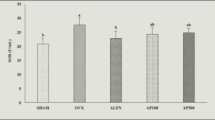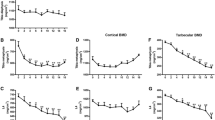Abstract
The preventive effect of phytocomponent p-hydroxycinnamic acid (HCA) on ovariectomy (OVX)-induced bone loss was investigated. HCA (250 or 500 μg/100 g body weight) was orally administered once daily for 30 days to OVX rats. The analysis using a peripheral quantitative computed tomography (pQCT) showed that OVX caused bone loss in the femoral-metaphyseal tissues. This change was significantly restored after the administration of HCA (250 or 500 μg/100 g body weight) to OVX rats. Mineral content, mineral density, and polar strength strain index in the femoral-metaphyseal tissues were significantly decreased in OVX rats. These decreases were significantly restored after the administration of HCA (500 μg/100 g) to OVX rats. Moreover, OVX caused a significant decrease in calcium content or alkaline phosphatase activity in the femoral-diaphyseal and -metaphyseal tissues. These decreases were significantly restored after the administration of HCA (250 or 500 μg/100 g) to OVX rats. Deoxyribonucleic acid (DNA) content in the diaphyseal or metaphyseal tissues was significantly increased in OVX rats. These increases were significantly restored after oral administration of HCA (500 μg/100 g). This study demonstrates that HCA has preventive effects on OVX-induced bone loss of rats in vivo.







Similar content being viewed by others
References
Wild RA, Buchamain JR, Myers C et al (1987) Declining adrenal androgen an association with bone loss in aging woman. Proc Soc Exp Biol Med 186:335–360
Cooper C, Melton J III (1995) Epidemiology of osteoporosis. Trends Endocrinol Metab 3:224–229
Promislow JHE, Goodman-Gruen D, Barret-Connor E et al (2002) Retinol intake and bone mineral density in the elderly: the rancho brenardo study. J Bone Miner Res 17:1349–1358
Bonjour J-P, Schurch M-A, Rozzori R (1996) Nutritional aspects of hip fractures. Bone 18:1395–1445
Yamaguchi M (2002) Isoflavone and bone metabolism; Its cellular mechanism and preventive role in bone loss. J Health Sci 48:209–222
Yamaguchi M (2006) Regulatory mechanism of food factors in bone metabolism and prevention of osteoporosis. Yakugaku Zasshi 126:1117–1137
Lai YL, Yamaguchi M (2006) Phytocomponent p-hydroxycinnamic acid stimulates bone formation and inhibits bone resorption in rat femoral tissues in vitro. Mol Cell Biochem 292:45–52
Lai YL, Yamaguchi M (2007) Phytocomponent p-hydroxycinnamic acid inhibits osteoclast-like cell formation in mouse bone marrow cultures. Int J Mol Med 19:123–128
Lai YL, Yamaguchi M (2006) Oral administration of phytocomponent p-hydroxycinnamic acid has anabolic effects on bone calcification in femoral tissues of rats in vivo. J Health Sci 52:308–312
Yamaguchi M, Uchiyama S, Lai YL (2007) Oral administration of phytocomponent p-hydroxycinnamic acid has a preventive effect on bone loss in streptozotocin-induced diabetic rats. Int J Mol Med 19:803–807
Uchiyama S, Yamaguchi M (2006) Oral administration of β-cryptoxanthin prevents bone loss in ovariectomized rats. Int J Mol Med 17:15–20
Yamaguchi M, Oishi H, Suketa Y (1987) Stimulatory effect of zinc on bone formation in tissue culture. Biochim Pharmacol 36:4007–4012
Walter K, Schutt C (1965) Acid and alkaline phosphatase in serum. In: Bergmeyer HV (ed) Methods of enzymatic analysis, vol 1–2. Academic Press, New York, pp 856–860
Lowry OH, Rosebrough NJ, Farr AL et al (1951) Protein measurement with the Folin phenol reagent. J Biol Chem 193:265–275
Flanagan B, Nichols G Jr (1962) Metabolic studies of bone in vitro. IV. Collagen biosynthesis by surviving bone fragments in vitro. J Biol Chem 237:3687–3692
Ceriotti G (1955) Determination of nucleic acids in animal tissues. J Biol Chem 214:39–77
Majeska RJ, Wuthier RE (1975) Studies on matrix vesicles isolated from chick epiphyseal cartilage. Association of pyrophosphatase and ATPase activities with alkaline phosphatase. Biochem Biophys Acta 391:51–60
Canalis E, Centrella M, Buech W (1989) Insulin-like factor I mediates selective anabolic effects of parathyroid hormone in bone cultures. J Clin Invest 83:60–65
Author information
Authors and Affiliations
Corresponding author
Rights and permissions
About this article
Cite this article
Yamaguchi, M., Lai, Y.L., Uchiyama, S. et al. Oral administration of phytocomponent p-hydroxycinnamic acid prevents bone loss in ovariectomized rats. Mol Cell Biochem 311, 31–36 (2008). https://doi.org/10.1007/s11010-007-9689-x
Received:
Accepted:
Published:
Issue Date:
DOI: https://doi.org/10.1007/s11010-007-9689-x




